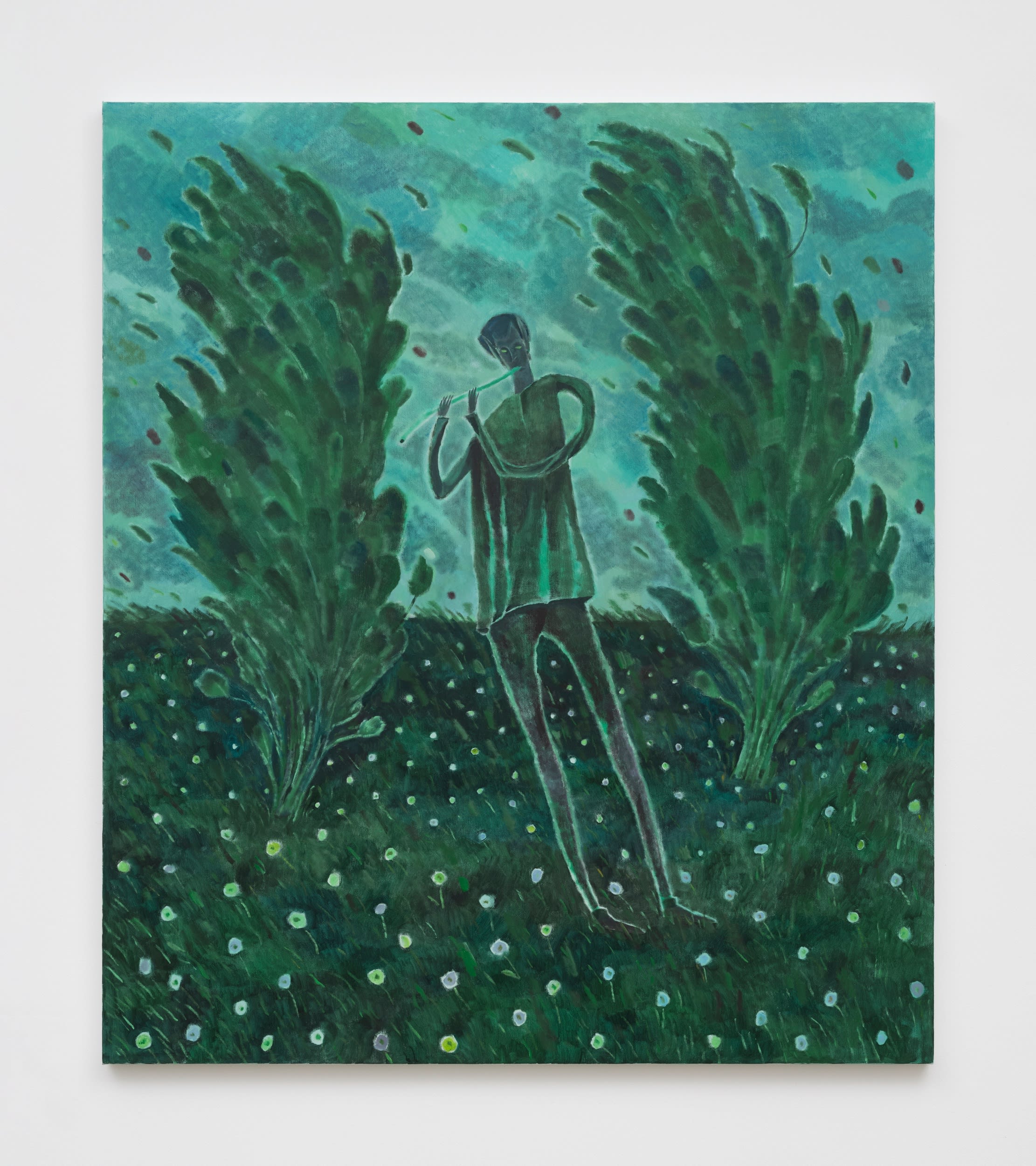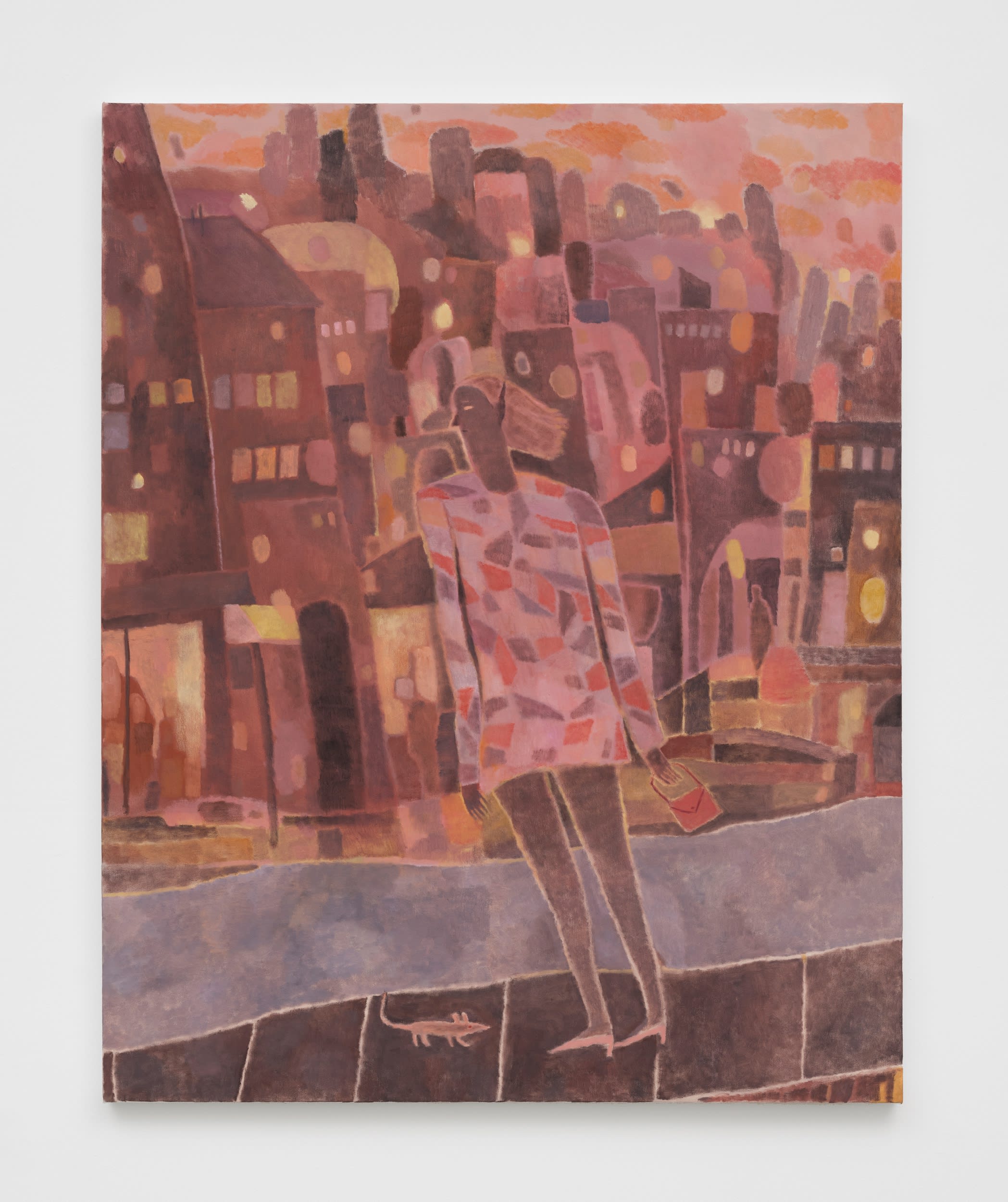Chase Biado Debuts in New York with a Solo Show at DIMIN
By: Vittoria Benzine
February 24, 2024
In 1801, an English physicist demonstrated once and for all that light consists of waves — not particles. Subsequent scientific revelations have cast further uncertainty on collective concrete impressions of reality. Nonetheless, humanity holds fast to a preconceived sense of unbudging logic. LA-based artist Chase Biado, though, imagines the impossible. Elf Energy, his first New York solo show, proposes alternate playgrounds where mythic beings navigate invented physics.
Elves inspired by the artist’s lifelong love for Tolkien populate a bright but hazy, vintage-coded metropolis dubbed “Elf City” — shaped, perhaps, by Biado’s own experience. He relocated from Portland to LA in 2015 and returned to New York for the first time in eight years to celebrate this show’s opening. “The last time I was here, I didn’t have any access to the art world,” Biado said amongst the main gallery’s nine large paintings. “It feels very different.” As different, one could say, as the tiny painting he’s tucked up above them all, intended to act as the show’s talisman.
The second, more intimate room in Elf Energy pairs a pensive painting with a series of textured bells suspended from the ceiling on long, thin chains. These bronze casts of wax hail from A History of Frogs — an ongoing, collaborative series by Biado and his partner, Antonia Pinter. This project embraces uncertainty, too. Biado isn’t sure if the elves and frogs know each other.

Chase Biado - Tea Time, 2024. Oil on linen; 60 x 52 in 152.4 x 132.1 cm
The Secret Lives of Elves
Since studying at Portland State University, Biado has worked across video, installation, and sculpture, experimenting with non-human characters all the while. He started painting again only five years ago. “It was like returning home,” Biado said, “allowing myself to do the thing I really wanted to do.” The pandemic held space to further hone his voice. “Those other mediums required so much wrangling and errands and people,” Biado said. He paints obsessively in the studio without references or a ruler. “It’s just me, brush, paint, canvas, and imagination,” he said.
A curtain of delicate sculptures from A History of Frogs appeared at Frieze LA in 2021. Last year, Biado presented Liquid Night, his second solo show as a painter, at The Pit. There, elves languished about in modern society, with all its loneliness. Focusing on solitary figures in empty scenes of single, supple tones, Liquid Night evoked Hollywood’s glamor, fantasy, and isolation.
Elf Energy feels distinctly New York. The show marks a shift for Biado from an “end of night feeling,” the release says, to a “beginning of night feeling,” depicting “Elven subjects en route to, or in the midst of a celebration.” Some people consider New York the easiest place to feel lonely — ironically, because there’s so many crowds around. “I’m not used to being so physically in proximity with so many people, like on the subways,” Biado said. Scintillating, multi-hued light keeps tempo for the busy elves, who all seem a bit separated from the activity surrounding them.

Chase Biado - Music for Field Mice, 2024. Oil on linen; 60 x 52 in 152.4 x 132.1 cm
Sound, Masquerading as Vision
Biado might not use references, but he does rely on Sun Ra and Herbie Hancock. “Every time a painting is going bad, I realize I’m painting in silence,” he said. Music stirs his strongest work.
Elf Energy breaks from the lush monochromes of Biado’s previous paintings for a more symphonic color theory. Over the past few years, the artist has tried painting tiles to portray music through sight. “The disco balls really became an object version of that,” Biado explained. Elf Energy marks the first time he’s painted disco balls. “That made me think about all the feelings around being on a dance floor, being a person among other bodies.”
Disco balls abound in roughly half the paintings on view. Elves regard their glittering scepters in varied partial views, exchanging secrets and reveling in silhouette, their elongated ears attuned to different frequencies than a human being’s might be. Most people rely on sight above all other senses. Here, however, Biado’s work borders on abstraction at new lengths too, as the elves conflate sight and sound in a manner akin to the compositions’ dreamy, warped proportions.
In the grand scheme of Biado’s world-building, Elf Energy tests this universe’s physics. He’s opted to relate to light as particles, which the artist calls “dust motes” and “lightning balls.” Their ether pervades cityscapes and forest clearings, defying the way light as we know it should work. In Energy Palace, a disco ball throws glitter on a wall it shouldn’t be able to reach, as an apprehensive elf contemplating entering the raucous party within gets blasted back by its frenzy.

Chase Biado - Elf City Sunset, 2024. Oil on linen; 60 x 48 in 152.4 x 121.9 cm
Art for the Age of Aquarius
The bombshell that light is not material struck at the end of the Enlightenment period. The fabled Age of Aquarius — a celestial period of human ascension that most astrologists say we’re entering — is similarly supposed to free society from enshrouded worldviews for the greater good. Some might argue that the shift from individual to collective values, which astrologists predict, is already becoming evident in the painting’s noted fascination with deconstructing the figure.
Biado, though, paints defined, realized characters. He makes art for the Age of Aquarius in the sense that his deconstructions transcend individuals to unravel reality itself. The stylish figure in Elf City Sunset wears a mod dress. Disco balls, though iconic today, evoke the 1970s. Biado said he set these scenes in the 1960s through 1980s mostly to honor his taste in music, his interest in Post-Impressionist art, and his proclivity to live in the past. But, there could be more.
“That’s another thing about Tolkien’s elves,” Biado and I realized that rainy day in TriBeCa, “their perspective on time is different — they’re hundreds of thousands of years old.” Time is a relative function in physics. Maybe for these elves, mid-century modern might as well be the present.
Pairing these paintings with bells from A History of Frogs corroborates Biado’s belief in imagined histories. He and Pinter are exploring a loose premise that humans evolved from — and potentially reverted back to — amphibians. History is written by the winners, after all. What if they were frogs? Inspired by antiquity, Biado and Pinter craft relics of imagined movements like “goblin Baroque” and “marsupial gothic” in functional objects. “I always liked frogs because they grow legs halfway through their life as they need to,” Biado said. These delicate bells can produce sound, accentuating the show’s melodies while underscoring Biado’s bold paintings. In Music for Field Mice, that room’s lone canvas, an elf plays to an empty, light-dappled meadow.
The Age of Aquarius will also favor play. Biado said bridging fantasy and art once felt “off limits,” as if he were “smuggling childhood interests into a contemporary conversation.” In reality, fantasy is a critical facet of adult life. “We’re having these epic mythological experiences — in our heads and in our relationships,” he said. “But on the exterior, we’re going about our daily lives.” Biado’s style, draped in jubilation, entices viewers to imagine, for a second, what else is possible.
The exhibition Elf Energy at DIMIN in New York will be on view until March 9th, 2024.
Featured image: Installation view. Elf Energy at DIMIN.


